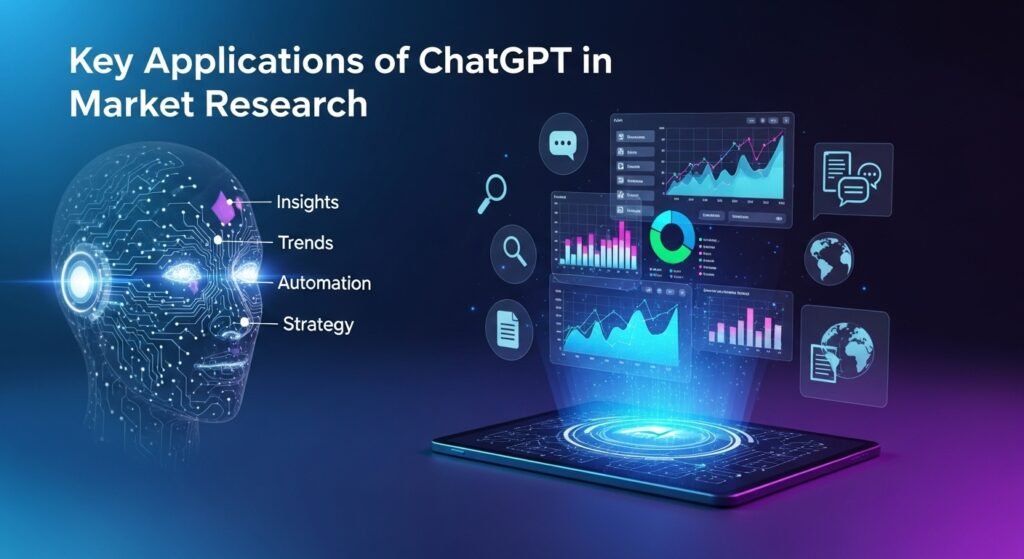Market research is the foundation of informed business decisions. It helps you understand your customers, analyze competitors, and spot industry trends. Traditionally, this process involves time-consuming tasks like surveys, focus groups, and data analysis. However, artificial intelligence, particularly ChatGPT, has made market research faster and more accessible.
ChatGPT, created by OpenAI, is a language model that generates human-like text based on user prompts. In 2025, its Deep Research feature takes this a step further by searching the web, analyzing multiple sources, and compiling structured reports.
Getting Started with ChatGPT for Market Research
Before diving into specific applications, you need to know how to set up and use ChatGPT effectively.
Accessing ChatGPT
As of August 2025, ChatGPT is available through OpenAI’s website and various integrated platforms. Ensure you’re using a version that includes the Deep Research feature, which enhances its ability to gather and analyze data from online sources. Check OpenAI’s official site for access details: OpenAI.
Crafting Effective Prompts
The quality of ChatGPT’s responses depends on how you phrase your questions. Here are key tips for creating effective prompts:
- Be Specific: Clearly state what you want. For example, instead of “Who is my target audience?” ask, “What are the age, income, and preferences of people buying organic skincare products in California?”
- Use Role-Playing: Instruct ChatGPT to act as an expert, such as “Act as a market research analyst with 10 years of experience.”
- Iterate: If the response isn’t what you need, refine your prompt or ask follow-up questions. For example, “Can you provide that data in a table format?”
Leveraging Deep Research for In-Depth Analysis
Deep Research is a powerful feature introduced in 2025, enabling ChatGPT to perform complex research tasks. It searches the web, analyzes text and PDFs, and compiles well-cited reports, making it ideal for market research.
What is Deep Research?
Deep Research uses OpenAI’s o3 model, optimized for web browsing and data analysis. It breaks down broad questions into subtopics, searches multiple sources, cross-references information, and presents findings in a structured format. This feature is particularly useful for gathering up-to-date market data.
How to Use Deep Research
Follow these steps to maximize Deep Research:
- Enable Deep Research Mode: In the ChatGPT interface, select the Deep Research option for your query.
- Use the C.P.R. Framework:
- Context: Explain who you are and what you’re researching. For example, “I’m a small business owner launching a fitness app.”
- Prioritize: Specify the timeframe (e.g., 2024-2025) and preferred sources (e.g., industry reports, customer reviews).
- Refine: Request a specific output format, like bullet points or tables.
- Answer Clarification Questions: ChatGPT may ask for more details to refine its search. Provide clear responses.
- Monitor the Process: Check the sources ChatGPT uses to ensure they’re reliable. Redirect if needed.
- Review and Refine: Examine the report for accuracy and ask for adjustments if necessary.
- Expand Research: Use follow-up prompts to explore related topics or deepen insights.
Example Prompts for Deep Research
| Research Type | Prompt | Output |
|---|---|---|
| Competitor Analysis | “Analyze the top 5 competitors in the electric vehicle market. Compare pricing, features, and customer sentiment using 2024-2025 data from TrustPilot and industry reports. Present in a table with citations.” | A table comparing competitors’ pricing, features, and customer feedback. |
| Market Trends | “Identify major trends in the renewable energy sector for 2025. Focus on technology, funding, and consumer behavior. Summarize with impact scores.” | A summary of trends with scores indicating their market impact. |
| Customer Sentiment | “Examine reviews of [product] on Reddit and TrustPilot from 2024-2025. Identify praises, complaints, and feature requests. Provide quotes.” | A report with key customer sentiments and direct quotes. |
Key Applications of ChatGPT in Market Research

ChatGPT can be applied to various market research tasks, each offering unique insights to inform your strategy.
1. Competitor Analysis
Understanding competitors helps you position your product effectively. ChatGPT can analyze competitors’ strengths, weaknesses, and strategies.
Example Prompts:
- “List the top 5 competitors in the online education industry and describe their unique selling points.”
- “Compare the pricing models of Netflix, Hulu, and Disney+. How do they target different audiences?”
- “Analyze the marketing campaigns of Coca-Cola and Pepsi in 2024. What made them successful?”
2. Market Trend Identification
Staying ahead of trends gives you a competitive edge. ChatGPT can identify shifts in consumer behavior and industry developments.
Example Prompts:
- “What are the latest trends in sustainable fashion for 2025? Focus on consumer preferences.”
- “How has remote work impacted the demand for co-working spaces in 2024-2025?”
- “Identify technological advancements in the healthcare sector for 2025.”
3. Product Development Research
Validating product ideas and understanding customer needs are critical. ChatGPT can analyze feedback and suggest improvements.
Example Prompts:
- “What are the most common complaints about smart home devices? Suggest solutions.”
- “Analyze user reviews of fitness apps to identify the top three liked and disliked features.”
- “What are emerging needs in the mental health app market?”
4. Market Sizing and Segmentation
Estimating market size and segmenting customers help in strategic planning. ChatGPT can provide data-driven estimates.
Example Prompts:
- “Estimate the total addressable market for electric scooters in the US for 2025.”
- “Segment the market for online grocery delivery by demographics and behavior.”
- “What is the serviceable obtainable market for eco-friendly cleaning products targeting millennials?”
5. Pricing Strategy Research
Setting the right price is key to profitability. ChatGPT can analyze competitive pricing and customer perceptions.
Example Prompts:
- “Compare pricing strategies of leading smartphone brands in 2025.”
- “What is the average price for subscription-based meal kits? How does it vary by region?”
- “Analyze reviews to see if customers find [product] reasonably priced.”
Advanced Techniques and Integrations
To enhance ChatGPT’s utility, integrate it with other tools and customize its responses.
- Zapier Integration: Automate workflows by connecting ChatGPT with survey tools or CRMs. For example, feed survey data into ChatGPT for analysis and send results to a spreadsheet. Learn more at Zapier.
- Custom Instructions: Set preferences for recurring tasks to streamline responses.
- Other AI Tools: Combine ChatGPT with sentiment analysis or predictive modeling tools for deeper insights.
Is ChatGPT Good for Translations?
Limitations and Best Practices
While powerful, ChatGPT has limitations that require careful consideration.
Limitations
- Inaccurate Information: ChatGPT may generate plausible but incorrect data, known as hallucinations.
- Data Currency: Without Deep Research, it may lack the latest information.
- Bias: Responses may reflect biases in training data.
Best Practices
- Validate Outputs: Cross-check with reliable sources like industry reports or customer data.
- Use as a Starting Point: Combine ChatGPT with traditional methods like surveys for comprehensive research.
- Stay Updated: Keep abreast of AI advancements to leverage new features.
Conclusion
ChatGPT, with its Deep Research feature, is a game-changer for market research in 2025. It offers a fast, cost-effective way to gather insights on competitors, trends, and customers. By following this guide, you can use ChatGPT to enhance your research efforts and make informed decisions. As AI continues to evolve, staying updated on tools like ChatGPT will keep you ahead in the competitive business landscape.
